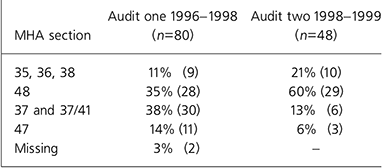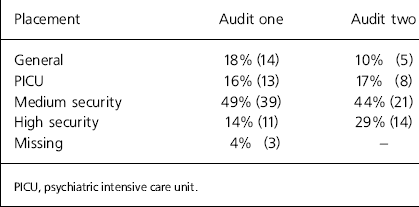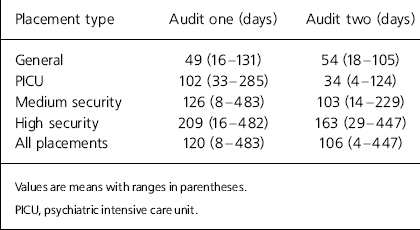The aim of this audit was to describe and compare the transfers of prisoners to psychiatric services for the year 1 December 1998 to 1 December 1999, following the partnership between Oxleas and HMP Belmarsh, with prisoner transfers in previous years.
Method
Patient information was collected on the database at HMP Belmarsh, with a specific subsection designed for the referral and transfer process from 1 December 1998 to 1 December 1999. Previous audit figures were available from 1 June 1996 to 1 June 1998. Broadly similar data were available over the period of the study. The data collected comprised demographic details, the nature of placements and the frequency of sequential referrals. The times to assessment and outcome were noted. The transfer time of the patient is the number of days from the point of first referral to subsequent transfer to psychiatric hospital. Because the data did not meet the requirements of a parametric test, the analysis used was the Mann—Whitney test.
Background to the audit
It is Government policy that, wherever possible, mentally disordered offenders (MDOs) should receive care and treatment from health and social services. In the Circular 66/90 Home Office and Department of Health (1995) report it was recommended that the clinical criteria for urgent psychiatric transfer from prison should not differ from those that apply to a person in the community requiring urgent admission to hospital. The Home Office has been actively encouraging the use of the emergency provisions of the Act.
Numerous studies over recent years have reported the prevalence of mental disorder in prisoners and their treatment needs (Reference Gunn, Maden and SwintonGunn et al, 1991; Reference Birmingham, Mason and GrubinBirmingham et al, 1996; Reference Brooke, Taylor and GunnBrooke et al, 1996). Other studies have reported difficulties in the referral process of prisoners to health services (Reference CoidCoid, 1988; Reference Smith, Crowe and JohnsonSmith et al, 1992). The HM Inspectorate of Prisons report for 1997 (Prison Service, 1999) highlighted the shortfall in the provision of health care to prisoners and laid out clear recommendations for immediate and future changes and further concerns in relation to mental health needs. The Department of Health (1999) recommended a formal partnership between the NHS and the prison service to improve the health and care of prisoners. More recently, others have drawn attention to the mental health needs of prisoners (Reference SmithSmith, 1999; Reference Reed and LyneReed & Lyne, 2000).
The Bracton Centre, Oxleas NHS Trust, has had some involvement with providing psychiatric care for HMP Belmarsh since 1991, although the extent of provision has varied over time. In December 1998 the trust and prison developed a partnership agreement to provide psychiatric care to the prison, with a consultant-led team being based at Belmarsh.
Overall picture of the patient group
The prisoners referred and transferred to hospital under the Mental Health Act 1983 for the period of 1 year from 1 December 1998 are described. Forty-eight patients were transferred during this period, ranging in age from 20-58 years. In terms of ethnicity, 28 (58%) were White European, 11 (22%) were Black Caribbean, 6 (13%) were Black African and 5 (10%) were of other origin.
In relation to the alleged offence, 25 (52%) were violent in nature, including 12 murder charges, 8 (17%) were sexual offences, 6 (13%) were criminal damage offences and 8 (17%) were acquisitive offences. A total of 19 cases (40%) were the responsibility of neighbouring mental health trusts and 31 (60%) were the responsibility of other mental health trusts, including 5 (10%) from outside the London region.
A further group of 20 prisoners who had been referred during this period but had not been transferred consisted of five prisoners rejected for transfer, two released prior to transfer, seven prisoners awaiting assessment outcome and a further six prisoners who had already been accepted by an outside service but were still awaiting transfer. Some prisoners in this last group had already experienced lengthy delays (range 10-180 days). One prisoner died in custody while awaiting a bed.
In all but five cases (10%) the working diagnosis was a primary psychotic illness. Transfers were under the category of mental illness in 46 cases (96%), psychopathic disorder in another case and learning disability for the remaining case.
Audit
During the reported 1-year period (audit two) there has been an increase in the annual number of prisoners transferred. Figures over the 2-year period 1996-1998 (audit one) show 80 transfers in this period. The age range was similar to previous audits (20-58 years compared with 20-61 years).
Section of Mental Health Act
In the most recent year (1998-1999) there has been a large increase in the proportion of prisoners transferred under Section 48 of the Mental Health Act, which was used in 60% of cases. The number of prisoners transferred on hospital orders (Section 37 and Section 37/41) and sentenced (Section 47) has decreased (see Table 1).
Table 1. Section of the Mental Health Act (MHA)

| MHA section | Audit one 1996-1998 (n=80) | Audit two 1998-1999 (n=48) |
|---|---|---|
| 35, 36, 38 | 11% (9) | 21% (10) |
| 48 | 35% (28) | 60% (29) |
| 37 and 37/41 | 38% (30) | 13% (6) |
| 47 | 14% (11) | 6% (3) |
| Missing | 3% (2) | - |
Service type
A greater proportion of prisoners were transferred to high security (Broadmoor, n=6; Ashworth, n=5, Rampton, n=3) during the most recent year. Similar proportions of prisoners were transferred to medium security and placements of lesser security (see Table 2).
Table 2. Service type

| Placement | Audit one | Audit two |
|---|---|---|
| General | 18% (14) | 10% (5) |
| PICU | 16% (13) | 17% (8) |
| Medium security | 49% (39) | 44% (21) |
| High security | 14% (11) | 29% (14) |
| Missing | 4% (3) | - |
Delay in transfer
The transfer times across all placement types did not differ significantly between audit one and audit two (Z=-0.2958, P>0.05). The transfer time was studied by placement type and the results indicate a trend of increasing delay with the level of security (Table 3). Of note is the very short transfer time to the psychiatric intensive therapy unit placements in audit two, which were almost all in private facilities and virtually all the prisoners transferred there were from an area local to the prison.
Table 3. Delay in transfer

| Placement type | Audit one (days) | Audit two (days) |
|---|---|---|
| General | 49 (16-131) | 54 (18-105) |
| PICU | 102 (33-285) | 34 (4-124) |
| Medium security | 126 (8-483) | 103 (14-229) |
| High security | 209 (16-482) | 163 (29-447) |
| All placements | 120 (8-483) | 106 (4-447) |
Comment
Over the first year of this service there was an increase in the number of prisoners transferred compared with the average number of transfers over the previous 2 years, but delays in transfer remained lengthy and formed a predictable response from services. We found the unavailability of beds to be the most common reason for delay in the transfer process, with other reasons being the differences in opinion regarding the level of security required, legal reasons, diagnostic disagreements resulting in repeated referrals and assessments, long delays to initial assessment (more than 6 weeks) and catchment area disputes.
To address the needs of prisoners requiring transfer, initiatives have included promotion of the use of urgent transfer orders (Section 48) and the national increase in the number of beds in medium security, including a sizeable proportion in the private sector. However, we experienced lengthy delays in the assessment process and the transfer of prisoners after acceptance by a service due to a lack of availability of beds across all levels of security. Transfers to local general services were characterised by lengthy delays, suggesting that direct community admissions take priority with the impression of a preference to await completion of court proceedings also playing a part.
A greater proportion of prisoners required high-security placements compared with previous years. This is explained in part by HMP Belmarsh now receiving all prisoners committed to the Central Criminal Court from the London area from other local prisons. It is noted that the referral process to high security is lengthy and this patient group often have a duplication of assessments impeding the access to appropriate care.
Home Office statistics reporting the annual number of transfers from prison to hospital in England and Wales indicate that 63% of patients admitted to hospital from prison in 1999 were unsentenced or untried and only 10% of all the transfers were to high security (Reference Johnson and TaylorJohnson & Taylor, 2000).
Prison statistics from the Annual Report of the Director of Health Care 1997-1998 (Prison Service, 1999) indicate shorter delays in transfer process. A total of 166 prisoners in England and Wales were recorded as awaiting transfer on 31 March 1998 and only 33 prisoners experienced a delay of greater than 28 days. This may be explained by only the cases where the Section papers have been submitted to the Home Office (in practice, when a bed is shortly available) or an order made in court. Contrary to expectation and clinical need, the use of emergency transfer under Section 48 in itself has no positive effect on the delay. An earlier report on transfers under Section 48 contrasts with this present finding (Reference Mackay and MachinMackay & Machin, 1998). In our study the best expeditor for prisoners is under the Sections of the Mental Health Act with a time limit imposed, that is Sections 37 and 38.
This audit has implications for NHS providers in prison, bearing in mind that the referrals of this prisoner group were made by experienced psychiatrists. There are difficulties of treating prisoners in custody; even those prisoners previously known to services may remain in prison on no medication while awaiting transfer if they decline treatment. Those prisoners who accept treatment may become lower in priority to transfer, while remaining vulnerable in a prison setting. It is clear that considerable work needs to be done on the organisation and coordination of the referral process. Measures need to be put in place to ensure greater continuity of care of prisoners under the Care Programme Approach.
Declaration of interest
S.I. is a former employee and J.P. is a present employee of Oxleas NHS Trust.






eLetters
No eLetters have been published for this article.